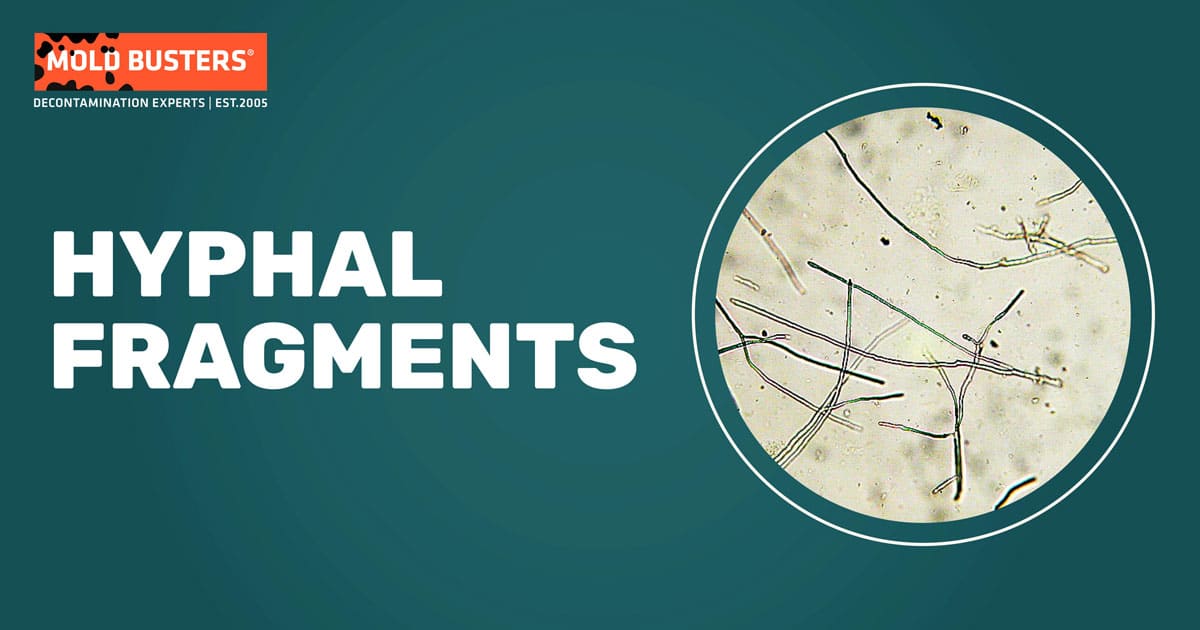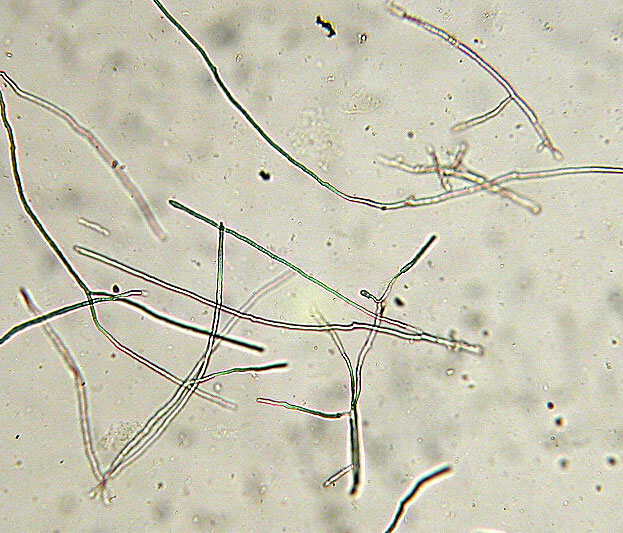Hyphal fragments
What are hyphal fragments?
Most molds have filamentous, branching, thread-like structures called hypha (plural: hyphae). These filaments grow from fungal spores, aggregate, and form the mycelium. Because of their structure, hyphae are often fragmented into smaller pieces, referred to as hyphal or fungal fragments, which can become airborne (1, 2). Hyphal fragments fall into bio-aerosols, which are tiny particles in the air that come from different living organisms, including molds (3).
Fungal spores, hyphae, and hyphal fragments can be frequently found in indoor environments, especially water-damaged buildings. Their presence indicates fungal growth and can potentially cause allergies and other health issues (4, 5). With that in mind, it is prudent to perform an air test in any living quarters and areas suspected of mold contamination. The following paragraphs serve as a more detailed explanation of that process and the potential dangers of hyphal fragments.
Concerned About Hyphal Fragments? Get a Free Inspection!
Hyphal fragments, part of mold structure, can be harmful and indicate hidden mold problems. Don’t leave it unchecked! Contact Mold Busters for a free virtual mold inspection. Our experts will provide a thorough assessment and a plan to address any mold issues, ensuring your home is safe. Act now to protect your health and property!
Hyphal fragments air test
In case of mold contamination of a residential or business building, an air test is performed after an initial assessment of the conditions in the building. Representative air samples are taken from every room of importance, including basements and attics. As with every test, a control sample is needed to assure the validity of the test. For this purpose, outdoor air samples are collected along with indoor samples on the same day to be analyzed together and compared (2, 6).

The level of bioaerosols should, in general, be lower in indoor samples than in outdoor samples. However, a lower level of fungal fragments in indoor samples does not automatically exclude the possibility of active fungal growth. When comparing indoor and outdoor samples, it is important to consider the season and weather conditions in which the outdoor samples were taken since the level of spores and hyphal fragments may significantly vary due to rain, evaporation, or temperature (2, 6).

Sample collection and analysis can be done in two different ways. Of course, a complete, thorough test should preferably incorporate both methods to ensure the most accurate and reliable overview of the fungal contamination. In most cases, the air is sampled by vacuum pumps that suck in air at a specific volume per minute. The vacuum pumps contain a chamber with a sticky surface or slide on which the particles are collected. Once the air sample is collected, the adhesive slide is removed from the vacuum pump and analyzed under a microscope to determine the total number of fungal particles (2, 6).
Measuring the total number of particles provides information on the levels of fungal spores, hyphae, and hyphal fragments in the air. However, to determine exactly which species of mold is growing in a contaminated area, how dangerous it is, and what would be the best decontamination method, it is necessary to apply discriminatory analyses. This entails sampling viable fungal materials and germinating them in a Petri dish, which is then analyzed to determine which species of mold it is (6). Some of the most commonly found species are Aspergillus versicolor, Penicillium brevicompactum, and Cladosporium cladosporioides (6, 7).

Did you know?
Penicillium / Aspergillus group is the most common toxic mold type found in homes we tested?! Find out more exciting mold stats and facts inside our mold statistics page.
Hyphal fragment normal and elevated levels
There is no specific regulation or measurement standard for air quality or the number of fungal particles present in air samples. Acceptable levels of fungal spores and fragments can vary significantly depending on the species of fungus in question, as well as outdoor conditions. In general, normal levels are calculated according to the levels of fungal particles in outdoor samples. The fungal particles in indoor samples should be qualitatively similar to the particles in outdoor samples, which means that the species cultivated from both samples types should be at the very least similar, if not the same. The number of total particles should also be quantitatively lower in the indoor samples and is measured by a cubic meter (2, 6).
Aspergillus sp. and Penicillium sp. spores are often grouped in total particle measurements because of their similarities and overall regular presence in air samples (2, 6, 8). However, the presence of certain fungi in indoor samples, even in low numbers, such as Stachybotrys sp. and Chaetomium sp., indicates serious contamination because these molds are rarely present in outdoor samples (2). According to the Alberta Health Services (6), it is not necessary to culture viable mold samples if the measured levels of fungal particles are within the given limits:
- Penicillium/Aspergillus ≤ 200 (for attics ≤400) counts/ m3
- Cladosporium species ≤300 (for attics ≤600) counts/ m3
- Alternaria species ≤100 (for attics ≤200) counts/ m3
- For other molds ≤100 (for attics ≤200) counts/ m3
Are hyphal fragments dangerous?
The role of hyphal fragments in respiratory illnesses has not yet been thoroughly researched. However, a number of studies indicate that exposure to hyphal fragments can increase the severity of asthma. In healthy individuals, fungal spores and hyphal fragments usually get trapped in the mucus in the nose and are easily expelled from the respiratory tract. In other cases, if the immune system is functional, these foreign fragments are quickly destroyed and removed from the body by macrophages, which are a type of white blood cell (4).
The reaction to hyphal fragment exposure depends on the length and intensity of the exposure, as well as the sensitivity of the immune system to specific fungi. It is important to note that it depends on the fungal species from which the hyphal fragments come. Fungi produce a variety of secondary metabolites (some of them can act as mycotoxins) that can have pathogenic, inflammatory, and allergenic effects. If the fungus in question produces certain mycotoxins, prolonged exposure might pose a serious health hazard (2, 9). Because of this, in case of suspected contamination by any mold, it is best to contact mold removal experts and schedule an air test to assess the situation.
If you are in Montreal or Ottawa, our team can assist you with this process. We also offer a virtual inspection service for your convenience.
References
- Madigan, M. T., Martinko, J. M., & Parker, J. (1997). Brock biology of microorganisms(Vol. 11). Upper Saddle River, NJ: Prentice hall.
- consumermoldguide.org
- Afanou, K. A., Eduard, W., Laier Johnsen, H. B., & Straumfors, A. (2018). Fungal fragments and fungal aerosol composition in sawmills. Annals of work exposures and health, 62(5), 559-570.
- Green, B. J., Tovey, E. R., Sercombe, J. K., Blachere, F. M., Beezhold, D. H., & Schmechel, D. (2006). Airborne fungal fragments and allergenicity. Medical Mycology, 44(Supplement_1), S245-S255.
- euro.who.int
- Mensah-Attipoe, J., Saari, S., Veijalainen, A. M., Pasanen, P., Keskinen, J., Leskinen, J. T., & Reponen, T. (2016). Release and characteristics of fungal fragments in various conditions. Science of The Total Environment, 547, 234-243.
- Li, D. W., & Kendrick, B. (1995). A year-round comparison of fungal spores in indoor and outdoor air. Mycologia, 87(2), 190-195.
- Øya, E., Becher, R., Ekeren, L., Afanou, A. K., Øvrevik, J., & Holme, J. A. (2019). Pro-inflammatory responses in human bronchial epithelial cells induced by spores and hyphal fragments of common damp indoor molds. International journal of environmental research and public health, 16(6), 1085.

Get Special Gift: Industry-Standard Mold Removal Guidelines
Download the industry-standard guidelines that Mold Busters use in their own mold removal services, including news, tips and special offers:
Published: August 23, 2021 Updated: June 24, 2024

Written by:
John Ward
Account Executive
Mold Busters
Fact checked by:
Michael Golubev
CEO
Mold Busters
